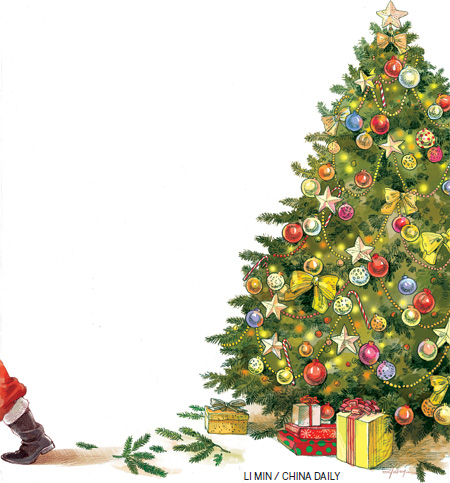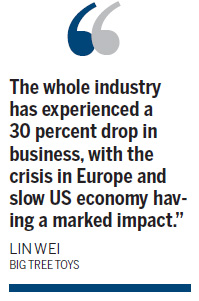A Christmas chill
Updated: 2011-12-16 08:57
By Alexis Hooi and Qiu Quanlin (China Daily)
|
|||||||||

|
|
Chinese manufacturers in the 'factory of the world' reliant on the festive buying season search for new ways to ward off economic woes in the West
Peng Hua watches over two of his factory workers as they string up a bunch of plastic pine needles on a wire before twirling them into a branch in a largely empty warehouse.
It is the beginning of December in the outskirts of the southern Chinese city of Shenzhen and the air is a comfortable 20 C, but the 41-year-old general manager of King Tree Handicrafts Company, a leading Christmas tree maker in the manufacturing hub, is starting to feel the chill of winter in the West.
"We are already experiencing the effects of the economic crisis. Things are probably going to worsen for our industry," Peng says.
King Tree is one of about 200 businesses in the area that help the country churn out 90 percent of the plastic Christmas trees used worldwide, Peng says. His company started making the trees in the late 1980s and rakes in about $20 million (15 million euros) a year. The US market makes up about 70 percent of the festive demand for its trees, with European buyers taking up most of the rest, he says.
|
||||
Peng says that amid this year's bleak global economy, demand is expected to decrease and quite a few smaller businesses have already folded. Still, orders have not plunged as many would expect even though major customers in the West already seem to be "downsizing" to simpler and cheaper products.
"A family that bought a tree with all the trimmings might now look for one without those for half the price," Peng says. "Many are also going for cheaper do-it-yourself products."
The full brunt of the slow US economy and Europe's debt crisis can only be felt when orders for next year's trees are received in the coming months, he says, but King Tree is bracing for lower profit margins.
"We were slowly recovering from the 2008 global financial crisis when business fell by up to 30 percent. But now, with the latest economic woes, we might see lesser growth of about 15 percent. That space is getting smaller and smaller," he says.
"Like many other industries here in Shenzhen, we also have to deal with other economic challenges like the rising cost of labor and raw materials."
Shenzhen has grown to become one of China's richest cities since it became a special economic zone in 1980 following the country's reform and opening-up. The city is located in Guangdong province's Pearl River Delta (PRD) region, a main engine of China's economic development fueled by low-cost manufacturing and export-oriented industries including textiles and electronics, mostly with initial investment from neighboring Hong Kong, that help make the province churn out one-quarter of the country's exports.
















